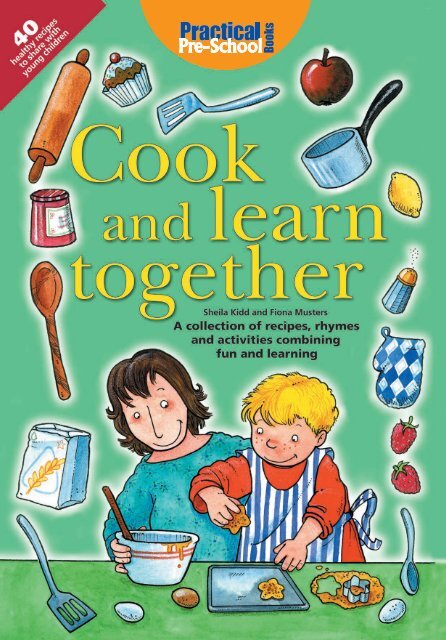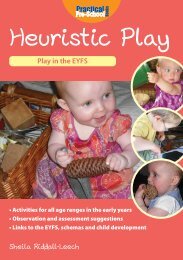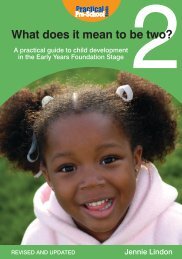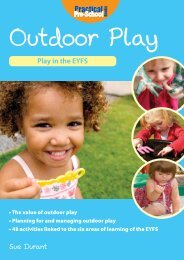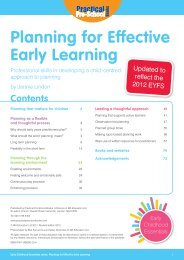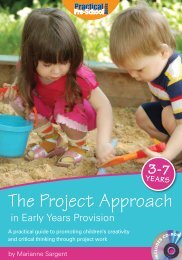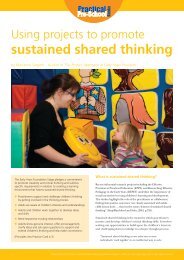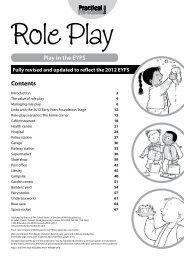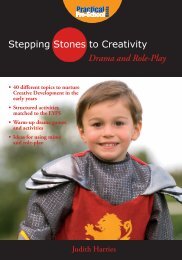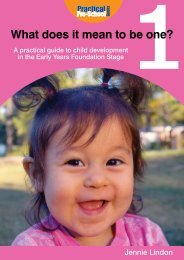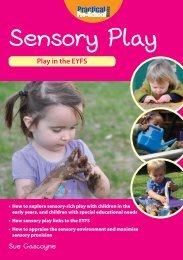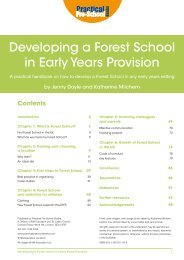Learning points - Practical Pre-School Books
Learning points - Practical Pre-School Books
Learning points - Practical Pre-School Books
Create successful ePaper yourself
Turn your PDF publications into a flip-book with our unique Google optimized e-Paper software.
<strong>Books</strong>
By Sheila Kidd and Fiona Musters<br />
Soups<br />
Vegetable soup 6<br />
Tomato soup 9<br />
Mushroom soup 11<br />
Salads, snacks<br />
and vegetables<br />
Egg, tomato and olive salad 14<br />
Celery and apple salad 14<br />
Avocado, orange and<br />
mozzarella salad 15<br />
Carrot, orange and<br />
raisin salad 17<br />
Panzanella 19<br />
Potato salad 21<br />
Cracked wheat salad 23<br />
Vegetable curry 25<br />
Tortilla 28<br />
Crudites and cheese dip 30<br />
Breads<br />
Basic bread 34<br />
Focaccia 38<br />
Pitta bread 39<br />
Pizza 41<br />
Hot cross buns 43<br />
Pastry<br />
Little savoury tarts 46<br />
Eccles cakes 49<br />
Flaky mushroom tarts 52<br />
Fish parcels 54<br />
Sausage/cheesy rolls 57<br />
Sausage plait 59<br />
Sausage, tomato and<br />
onion pie 61<br />
Puddings<br />
Jelly with fruit 64<br />
Fruit salad 66<br />
Apple charlotte 68<br />
Pancakes 70<br />
Cakes and<br />
biscuits<br />
Chocolate biscuit cake 74<br />
Birthday cake 76<br />
Flapjacks 79<br />
Cheese biscuits 81<br />
Shortbread biscuits 83<br />
Gingerbread men 85<br />
Fairy cakes 88<br />
Mini Christmas cakes 90<br />
No cook recipes<br />
Hummus bi tahini 93<br />
Marzipan sweets 95<br />
Chocolate fruit and<br />
nut clusters 97<br />
How cooking helps<br />
children learn 99<br />
Health and safety 111<br />
Illustrations and cover: Chantal Keys<br />
Food styling: Liz Franklin<br />
Photography: Roddy Paine<br />
Published by by Step <strong>Practical</strong> Forward <strong>Pre</strong>-<strong>School</strong> Publishing <strong>Books</strong>, Limited<br />
A Division of MA Education Ltd, St Jude’s Church,<br />
Dulwich 25 Cross Road, Street, Herne Leamington Hill, London, Spa, CV32 SE24 4PX 0PB<br />
Tel.<br />
Tel: 01926<br />
020 7738<br />
420046<br />
5454<br />
www.practicalpreschool.com<br />
www.practicalpreschoolbooks.com<br />
© Step Forward Publishing Limited 2004<br />
© MA Education Ltd 2004<br />
All rights reserved. No part of this publication may<br />
be reproduced, stored in a retrieval system, or<br />
transmitted by any means, electronic, mechanical,<br />
photocopied or otherwise, without the prior<br />
permission of the publisher.<br />
Cook and learn together<br />
ISBN: 1 904575 00 5<br />
C O O K A N D L E A R N T O G E T H E R<br />
1
Cooking with young children should be fun but it’s also a great way for<br />
them to learn. The food that you make together can be simple or<br />
complicated - the important thing is that you share an interest in all<br />
kinds of food.<br />
Many children already cook at<br />
home, others have never had the<br />
chance to mix and stir, to get<br />
their hands onto a piece of<br />
dough or lick out the bowl of a<br />
pudding mix. It is surprising<br />
how capable many young<br />
children are. Some of them will<br />
be able to handle suitable<br />
knives, graters and whisks. Most<br />
will be enthusiastic about<br />
making pastry, kneading bread<br />
dough and spreading toppings<br />
on pizzas. Behind the fun, there<br />
is a serious message – that they<br />
can enjoy food that is tasty,<br />
nourishing and healthy.<br />
About this book<br />
This book contains 40 recipes<br />
for children and adults to cook<br />
together as well as guidance on<br />
how cooking can help children<br />
learn. For professionals, we<br />
show how the activities fit in<br />
with the early years curriculum.<br />
There is advice on storing food<br />
safely and tips on good practice<br />
when cooking with young<br />
children. We also give guidance<br />
on foods which may not be<br />
acceptable for medical or<br />
religious reasons. These are<br />
things you need to check if<br />
you’re cooking with friends’<br />
children or children who are<br />
new to you.<br />
Recipes<br />
The recipes are organised into<br />
chapters – soups, breads, pastry,<br />
for example. There are also a<br />
number of no-cook recipes.<br />
Each recipe has:<br />
■<br />
■<br />
■<br />
■<br />
■<br />
■<br />
■<br />
■<br />
ingredients<br />
equipment<br />
how long it will take to<br />
prepare and cook<br />
what to do<br />
words you can use<br />
learning <strong>points</strong><br />
related activities<br />
ways to check what children<br />
have learned<br />
The activities can be adapted to<br />
suit the age of your children<br />
and to fit the time you have<br />
available.<br />
Ingredients<br />
The recipes have been tried and<br />
tested using the amounts shown,<br />
but there may be times when<br />
you want to substitute one<br />
ingredient for another.<br />
Margarine can be used instead<br />
of butter without making too<br />
much difference. Smaller<br />
ingredients which add texture<br />
and interest can be swapped<br />
easily, either for your<br />
convenience or to suit children’s<br />
tastes. Recipes containing nuts<br />
must be adapted for people with<br />
a nut allergy.<br />
Early learning<br />
In England, the Early<br />
<strong>Learning</strong> Goals set out<br />
what most children should<br />
be able to do by the end<br />
of the Foundation Stage<br />
of education.<br />
They cover six areas of<br />
learning: Personal, Social<br />
and Emotional<br />
Development;<br />
Communication, Language<br />
and Literacy;<br />
Mathematical<br />
Development; Knowledge<br />
and Understanding of the<br />
World; Physical<br />
Development and Creative<br />
Development.<br />
The Foundation Stage runs<br />
from when a child is three<br />
to the end of their first<br />
year of compulsory<br />
schooling (Reception<br />
class). Don’t expect your<br />
child to be achieving<br />
these goals when they are<br />
still in pre-school, aged<br />
three or four, as they will<br />
still be working towards<br />
them.<br />
Across the UK<br />
There are different<br />
guidelines for pre-school<br />
education in Wales,<br />
Scotland and Northern<br />
Ireland but they have<br />
many similarities. They<br />
may use different words<br />
or the same words in a<br />
different order – but the<br />
expectations are<br />
essentially the same.<br />
C O O K A N D L E A R N T O G E T H E R<br />
2
Equipment<br />
We provide a basic utensils list as<br />
well as some advice about<br />
electrical equipment. You<br />
should be able to make all the<br />
recipes with the equipment you<br />
have to hand in your kitchen at<br />
home. There are even some<br />
recipes that don’t need an oven.<br />
We list what you will need for<br />
each recipe but don’t forget that<br />
if you do not have a particular<br />
utensil you may be able to<br />
improvise. If you don’t have any<br />
pastry cutters, for example, the<br />
rim of a mug or cup will do the<br />
same job. A milk bottle makes a<br />
good rolling pin.<br />
Timing<br />
The preparation time is a rough<br />
guide. Obviously, the more time<br />
you take with children to ask<br />
and answer questions, to notice<br />
changes, to find similarities and<br />
differences, the more time you<br />
will need.<br />
Your children will want to see<br />
the result of their work and be<br />
eager to eat and share the food<br />
with friends or family, but try<br />
not to hurry so much that all<br />
the learning potential is lost.<br />
Allow enough time to complete<br />
the tasks and remember, most<br />
learning happens during the<br />
process of cooking not eating!<br />
Words you can use<br />
Each recipe has a short list of<br />
words you can use to expand<br />
children’s vocabulary.<br />
Occasionally, the words are<br />
linked to a scientific concept<br />
and so should not be altered.<br />
For example, melt and dissolve<br />
are two distinct processes and<br />
the words should be used<br />
accurately.<br />
<strong>Learning</strong> <strong>points</strong><br />
<strong>Learning</strong> <strong>points</strong> tell you what<br />
to draw to children’s attention<br />
and what kinds of questions to<br />
ask.<br />
Linked activities<br />
These are ideas for activities<br />
that are connected in some way<br />
with ingredients in the recipe.<br />
They could be used while you<br />
are waiting for the food to<br />
cook or as follow-up activities<br />
later in the day or week.<br />
<strong>Practical</strong> activities will help to<br />
broaden or deepen learning<br />
that has taken place during the<br />
cookery session. So, having<br />
looked at the oats used to<br />
make flapjacks, for example,<br />
you could show children that<br />
flour can be made from oats by<br />
grinding them in a make-shift<br />
pestle and mortar.<br />
What have children<br />
learned<br />
Each recipe includes some<br />
pointers in the form of<br />
questions to answer or signs to<br />
look for if you want to check<br />
what children have learned.<br />
Some <strong>points</strong> focus on older or<br />
more able children,<br />
recognising that children do<br />
not learn or develop at the<br />
same rate.<br />
TEACHING POINTS<br />
The early years<br />
curriculum<br />
Most of the recipes will<br />
help children to meet the<br />
same learning outcomes<br />
but there are some which<br />
have the potential for<br />
promoting a particular<br />
aspect of learning, for<br />
example melting the<br />
chocolate for the chocolate<br />
biscuit cake or looking at<br />
circles when cutting out<br />
Eccles cakes. The outcomes<br />
listed are the most<br />
significant and obvious<br />
ones for each recipe.<br />
Personal, Social and<br />
Emotional Development<br />
Every recipe will promote<br />
personal, social and<br />
emotional development -<br />
children will be trying new<br />
activities, concentrating,<br />
taking turns and learning to<br />
respect their own and other<br />
cultures. These outcomes<br />
are not listed.<br />
Involving parents<br />
Make time to listen to<br />
parents as they talk to you<br />
about their child’s attitudes<br />
to food and eating. They<br />
may have special cultural or<br />
religious knowledge of food<br />
and cooking which could be<br />
used to enhance the<br />
richness of children’s<br />
experiences. For example, a<br />
parent who can make<br />
chapattis would be able to<br />
show how breads come in<br />
many different forms.<br />
C O O K A N D L E A R N T O G E T H E R<br />
3
Apple charlotte<br />
Ingredients<br />
1 small stale white or<br />
wholemeal loaf<br />
100g melted butter<br />
Filling<br />
1kg apples<br />
50g butter<br />
50g raisins (optional)<br />
zest and juice of a lemon<br />
75-100g sugar<br />
1/2 teaspoon ground cinnamon<br />
Equipment<br />
saucepan<br />
bread knife and boards<br />
knives for children<br />
vegetable peeler or paring<br />
knife for adults<br />
charlotte mould or 4 individual<br />
foil pudding basins<br />
silver foil for wrapping<br />
tablespoon and teaspoon<br />
Most of us have left-over bread from time to time and there are many<br />
good ways of making use of this. Here is a recipe for a dish which is<br />
tasty and comes in many versions. Sometimes the bread is crumbed and<br />
layered between the cooked apple but in this one the bread has a<br />
crisper finish. In the autumn, you may have windfall apples from the<br />
garden that you can use. This could lead to a discussion about how we<br />
can use so many things which would otherwise be wasted.<br />
Method<br />
Cut the crusts off the bread and cut into the thinnest possible slices.<br />
Melt the 100g of butter in a pan. Dip the slices of bread into the butter and line<br />
the mould(s), saving enough for the lid(s).<br />
Peel the apples and cut into quarters, removing the cores, and let children cut<br />
these into small pieces on their boards.<br />
Melt the 50g of butter in the pan, add the apples and sugar. Cook, stirring<br />
occasionally, until soft. Stir in raisins if using, cinnamon, lemon juice and zest.<br />
Spoon into the moulds and cover with the reserved bread. Bake for 20 minutes<br />
or longer until golden. Cool and double wrap with foil if sending home.<br />
Oven: 200°C/400°F/Gas 6<br />
<strong>Pre</strong>paration time:<br />
25 minutes<br />
Cooking time: 20 minutes<br />
for individual pudding basins,<br />
40 minutes for one large mould<br />
C O O K A N D L E A R N T O G E T H E R<br />
68
<strong>Learning</strong> <strong>points</strong><br />
Words you can use: bread, stale,<br />
crusts, crumb, dip, mould, half, quarter,<br />
core, melt, line<br />
Compare the colour and texture of<br />
the crust to the inside of the loaf.<br />
The texture of the loaf may vary. In<br />
places there may be larger air<br />
spaces. If you are making this<br />
recipe in winter, keep the crusts to<br />
feed to the birds.<br />
As you dip the bread into the butter<br />
the slices will become heavier. The<br />
butter will quickly be soaked up.<br />
Ask children where the butter has<br />
gone. Explain what it means to line<br />
the mould with bread – this may be<br />
the first time they have heard the<br />
word ‘line’ used in this way. Talk<br />
about the mould and how their<br />
apple charlottes will be the same<br />
shape and size as the mould.<br />
Before cutting up the apples<br />
compare their colour and size. Can<br />
they find where the stalk grew As<br />
the apple is halved and quartered,<br />
count the number of pieces you<br />
have. Look for and count the seeds<br />
around the core.<br />
Help children to identify the<br />
changes in the apples as they are<br />
cooked.<br />
Count the spoons of apple as they<br />
are placed inside the mould.<br />
Discuss the size of bread which will<br />
be needed to cover the top. Use<br />
words that compare size: ‘larger’,<br />
‘smaller’, ‘wider’, ‘narrower’,<br />
‘longer’.<br />
Ideas for activities<br />
■<br />
■<br />
■<br />
■<br />
Use windfall apples to make<br />
apple prints with paint.<br />
Experiment with cutting the<br />
apple horizontally across the<br />
centre to see another pattern.<br />
At Hallowe’en, play a game of<br />
apple bobbing by hanging the<br />
apples up with string or<br />
floating them on water. (This<br />
activity is quite difficult and<br />
children will need an adult to<br />
help them.)<br />
Put a variety of containers, for<br />
example yoghurt pots, in your<br />
sand pit or sand tray so that<br />
children can understand more<br />
about using moulds.<br />
Make a display of different<br />
shapes, sizes and colours of<br />
apples. If you know them, use<br />
their variety name, for<br />
example Cox’s orange pippin.<br />
TEACHING POINTS<br />
Communication,<br />
Language and Literacy<br />
Use talk to organise,<br />
sequence and clarify<br />
thinking, ideas, feelings and<br />
events<br />
Mathematical<br />
Development<br />
Say and use number names<br />
Use mathematical ideas and<br />
methods to solve practical<br />
problems<br />
Use language such as<br />
‘smaller’ and ‘larger’ to<br />
compare size<br />
Knowledge and<br />
Understanding of the<br />
World<br />
Look closely at similarities<br />
and differences, patterns<br />
and change<br />
Ask questions about why<br />
things happen and how<br />
things work<br />
What have<br />
children learned<br />
Do children notice that the<br />
bread absorbs the melted<br />
butter<br />
Can they spot similarities<br />
and differences in size and<br />
colour between the apples<br />
Do they use mathematical<br />
language to compare the<br />
size and shape of the slices<br />
Involving parents<br />
Ask parents to spend time<br />
peeling, cutting and eating<br />
apples at home, or send in<br />
an apple for snack time.<br />
C O O K A N D L E A R N T O G E T H E R<br />
69


